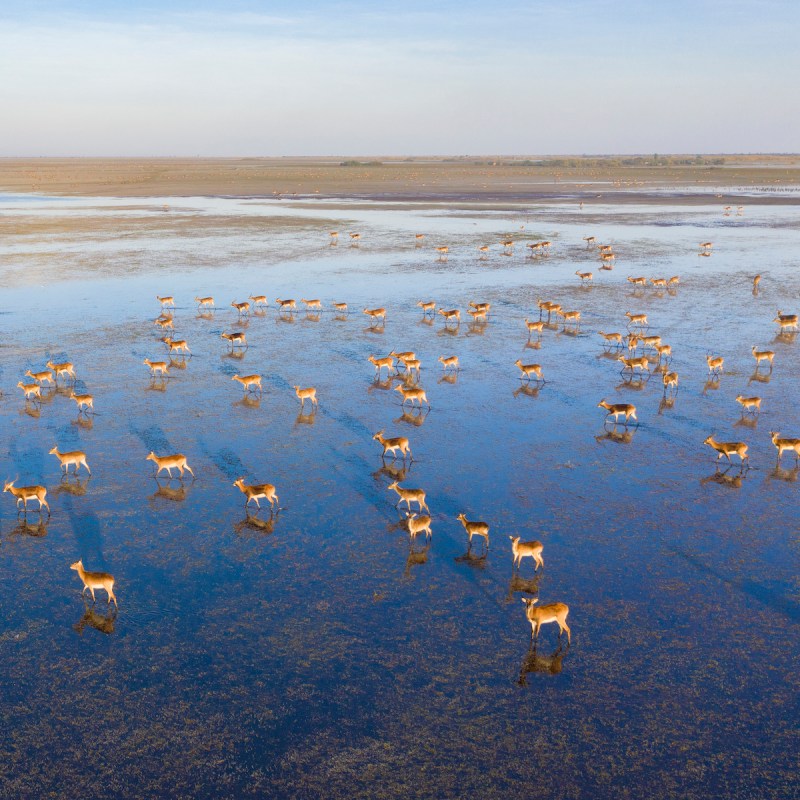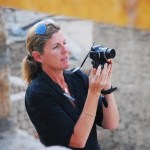
The sun is just starting to rise, the sky is turning from grey to pale pink with streaks of yellow and orange, and I am standing shivering on a muddy causeway, surrounded by mist, in the middle of the Bangweulu Swamps in Zambia. I am also surrounded by thousands of the endangered, endemic black lechwe that are found only in Zambia, predominantly in these swamps.
Videos by TravelAwaits
Why am I up at the crack of dawn? The answer to that is that I am on safari with long-time friend and professional wildlife photographer, Patrick Bentley. Patrick is on assignment to photograph the swamps and their inhabitants for Remote African Safaris and the wildlife conservation NGO African Parks, and my husband and I have come along. I have never been on safari with a professional photographer before and, over the next few days, as I watched Patrick at work, I learned a lot about patience, lighting, angle, subject matter, and more.
So whether you’re shooting on an iPhone or with an enormous zoom lens, let me pass on to you a couple of things I learned from spending some days in the bush with someone who really knows what he is doing with a camera.
With the privilege of seeing and photographing wildlife in their unspoiled natural environment comes the responsibility of doing so ethically. So let’s start with some general tips that I have picked up over many, many years of going on safari.
General Wildlife Photography Tips
1. Do Your Research
If you have a particular subject in mind, do your research on that animal. Learn, for example, about its behavior, habitat, and diet. Once you find the animal out in the bush, assess its behavior and take note if your presence is causing it discomfort. If you notice that an animal has stopped feeding, hunting, mating, or has abandoned a den or nest, then it’s time to back off!

2. Respect Their Environment
I understand it’s frustrating when things get in the way of your subject, but you should never alter the natural surroundings in any way. If a branch is in the way, move around it. If an animal is too far away, don’t go off-road to get closer — that is what zoom lenses are for! If out at night, take care with the spotlight. Use infrared filters when shining a light on wildlife, and avoid shining directly in an animal’s eyes, as this can cause temporary blindness. (While a red spotlight may not be ideal for night-time photography, it causes no harm to the animals, and camera settings can be adjusted to compensate for the red light).
3. Don’t Overcrowd Sightings
Animals can feel threatened by too many vehicles. While everyone wants a chance to see some particularly exciting sight, you should never compromise an animal’s comfort to get a photo. If you see too many cars around a sighting, sometimes the best thing to do is move on.

4. Let Sleeping Lions Lie
Sightings in the middle of the day can be tricky to photograph, as animals tend to rest in the shade during the midday heat. While I understand that a photo of a sleeping animal is not all that interesting, animals at rest must be left to do so. Do not throw or do anything to provoke a response or get a more “interesting” shot! Please don’t do what I have seen too many amateur photographers on safari do — whistle or clap or bang the side of their vehicle. By the same token, it’s also unethical to play pre-recorded wildlife sounds to animals or birds. Remember you’re in their home and not a zoo.

5. Respect Fellow Visitors In The Park
Notice other photographers and viewers at a sighting, and show respect by not driving in front of them or pressuring them to move. At the same time, be aware that other people may want to join a sighting, so don’t spend too much time hogging the prime spot.

6. Don’t Feed The Animals
Feeding animals change their behavior and attitude towards humans. While it may be tempting to throw a snack in the direction of a baboon, monkey, or bird to get a good shot, this can lead to problems down the line, and it’s the animals that will end up suffering.

7. Go Slow
Take your time with your subject. Some animals need to adjust to the presence of a safari vehicle, and may only relax after a while. The longer you spend waiting, the better chance you have of getting your shot.

8. Protect Them
After you get home from your safari and are sharing your wildlife photos, it’s important to do so responsibly. Take care when photographing endangered species or those susceptible to poaching. Remove any geo-location tags that poachers could use to locate animals, and remove EXIF (exchangeable image file format) data from photos to ensure that GPS coordinates will not be attached to them.
Beyond The Basics
For the average traveler, professional wildlife photography is not a natural gift, and without care, wildlife shots can end up with all thumbs, shadows, and the sort of photo that needs a magnifying glass to see the subject matter. So, now we’ve covered the basics, let’s get on to some tips to help you capture the amazing scenes you will be seeing on your safari.

9. Get Out Early And Stay Out Late
Tip one is exactly why I was out at sunrise in the swamps. Wildlife photography is all about the light, particularly the early morning and late afternoon light — this is what photographers call the “golden hour.” To get the perfect shot, you might need to set your alarm early!

10. The Lower The Better
When taking wildlife photos it’s a good idea to be as close to the ground as possible. An “eye to eye” angle gives the image a much more dramatic impact, and helps the right perspective, and shows the dimensions of the animal. Another advantage of shooting at a lower angle is the background of the picture will be what is behind the animal and not what’s below, making whatever you are taking a picture of stand out better.

11. “Look For The Eye”
Portrait photos can be one of your top shots on safari, so a tip here is when the opportunity arises, “look for the eye.” The eye of an animal can depict the animal’s mood, focus, and intent. So when taking a wildlife portrait, see if you can get the eye of your subject sharply in focus; to do this you will need to take control of your camera’s autofocus, making sure you focus on the eye and not the nose, ear, or cheek! Another tip is to look for the “glint” in its eye, this will make for a much better shot than a dark or dull eye.

12. Choose The Correct Shutter Speed
Choosing the correct shutter speed when trying to capture wildlife in action is key! If the shutter speed isn’t high enough, the image will come out blurry. Shutter speed also affects the clarity and sharpness of your photo. Before you go on safari, try playing around with your camera at home, using your pet or passing cars to help you figure out the right shutter speed for moving subjects.

13. Be Prepared For The Perfect Moment
A professional wildlife photographer will often sit waiting for that “perfect moment,” long after other safari vehicles have gotten bored and moved on. Make use of the wait time to take practice shots of the scene and see how they look on your camera screen. You can always delete these afterward, but this gives you the opportunity to adjust your settings so the shot is exactly how you want when the action finally happens.

14. Look For Frames Within The Frame
Consider using environmental elements to frame your subject. This can add an interesting aspect to an image. Something like an overhanging branch or framing vegetation can serve to place the subject in the context of the environment in a creative way.

15. Capturing Moving Subjects
If your subject is moving, it is critical to change your autofocus setting, so read your camera’s manual before you travel. When the time comes, keep your moving subject in the viewfinder and pan with it, trying to keep the focus selector on its head. Keep your finger depressing the shutter button halfway, so your camera’s focus will track your subject’s movement. Every few seconds, remove your finger completely from the shutter button to refocus on your subject.

16. Work With The Environment
A lot of people are trying to find that “clean picture,” where there are no branches in the way, no leaves, no shadows. Of course, that crystal clear photograph where the subject is bathed in perfect light is what you are looking for, but conditions are not often perfect. Often, it’s the imperfections that make an image beautiful. Shadows, dust, rain, branches, twigs, and leaves all create atmosphere and emotion in an image.
Hopefully, armed with these tips, you will come home with a “trophy shot” or two from your next safari.
The Best Seasons For Wildlife Photography
When is the best season for wildlife photography? Well, it’s always a good time to be on safari, but certain times are better than others…
Southern Africa: The best season for wildlife photography in Southern Africa (Zambia, Botswana, Zimbabwe, South Africa) is the dry season, July through October. Game viewing is best from August onward when animals congregate in large herds and grass is shorter allowing for best viewing.
November through December is a great “predator season,” though there’s always a chance of thunderstorms. Being shoulder season, you won’t be paying peak season accommodation rates.
December through March is the wettest season. Many camps are closed, but others stay open. This is the time to see the most birds.
April to May are beautifully clear months with wonderful temperatures. There’s plenty of animals, but the grass can be high, making them difficult to see. This is also a good time for “shoulder season” rates.
East Africa: The game viewing in East Africa is great all year round, particularly in the Maasai Mara and Serengeti regions, where plains are open and wildlife easy to see. If you want the migration, then come February–July in Tanzania and July–September in Kenya. Out of those seasons, you will see fewer people and get better rates. Many camps are closed during the long rains, April through May.
Safaris are a fantastic way to experience wildlife up close and personal:
